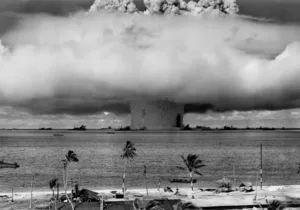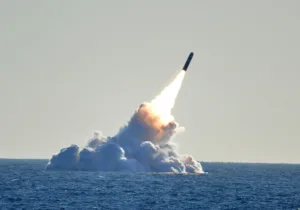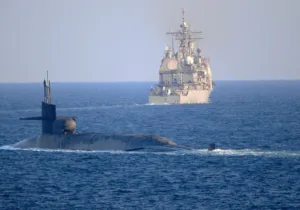Three decades ago, there were nine countries that fielded ballistic missiles. Today, there are 31. Not coincidentally, the world has seen an increase of more than 1,200 ballistic missiles since 2010.[i]
Several of these missile-wielding countries are unfriendly (Iran and North Korea) or unstable (Pakistan and Egypt) or under internal threat (Saudi Arabia) or all of the above (Syria). Some missile threats aren’t even countries: Hezbollah has a massive arsenal of rockets and missiles, and an Australian man was nabbed for assisting ISIS with advanced missile technology.[ii]
Because of the nature of their regimes—adjectives like paranoid and terrorist come to mind—North Korea and Iran are perhaps the most worrisome of the world’s missile threats. To be sure, other regimes have larger, more lethal arsenals (China and Russia), but those other regimes are rational and relatively stable, which means the old rules of deterrence apply. That may not be the case with Iran and North Korea, which is why the advancement and deployment of missile defenses must become a centerpiece of American foreign policy and national security strategy.
Threatening Skies
In mid-2017, North Korea test-fired what appears to be a full-fledged ICBM, leading some missile experts to conclude Pyongyang’s missilery could reach Los Angeles or even Chicago. The Defense Intelligence Agency (DIA) assesses North Korea could have a “reliable, nuclear-capable ICBM”[iii] program in 2018.
In March 2017, North Korea test-launched four medium-range ballistic missiles on a single day. According to weapons experts, the regime’s earlier September 2016 nuclear-weapons test indicated “progress towards developing a miniaturized nuclear warhead.”[iv] Back in 2015, we learned that North Korea had produced enough nuclear material for 20 nuclear warheads. But by mid-2017, U.S. intelligence agencies concluded that Pyongyang has produced as many as 60 nuclear warheads. All of this raises the specter of nuclear blackmail, widespread nuclear proliferation, EMP attack, and of course nuclear war.[v]
Since 2006, Pyongyang has conducted five nuclear tests and multiple short-range and medium-range missile tests.[vi] It has tested an intermediate-range missile that brings Guam and the westernmost parts of the Alaska island chain in range, along with “space launch vehicles,” which are poorly disguised ICBMs.[vii] Equally worrisome, North Korea has tested submarine-launched missiles, making the missile’s range irrelevant.
North Korea is intent on mating its nuclear capability with long-range missilery. “We have long assessed that the North Koreans have the capability to fit a nuclear weapon in a warhead on a missile,” then-Director of National Intelligence James Clapper reported in 2016.[viii] DIA reported in July 2017 that Pyongyang may have mastered the ability to miniaturize a nuclear warhead. Pentagon officials assess North Korea’s nuclear-capable KN-08 ICBM to be operational.[ix] That brings all of Alaska, Hawaii, and the western part of the continental U.S. in range.[x] This is a regime, it pays to recall, that warned in 2013 it was prepared to launch “a preemptive nuclear attack” against the U.S. and South Korea.
“They’re approaching their missile development in a very pragmatic way,” satellite-imagery analyst Joseph Bermudez told the Washington Post. “They are testing, and they are testing often,” he explains. “This is the way you really learn how to develop a ballistic missile, and that’s what worries me.”[xi] Indeed, under Kim Jong Un, North Korea has detonated more nuclear devices and test-launched more missilery in six years than it did under his father’s 14-year regime.[xii]
In January 2017, Iran tested a medium-range ballistic missile. In 2015 and again in 2016, the Islamic Republic tested missiles capable of delivering nuclear weapons—in violation of UN Security Council resolutions. Iran appears to be focusing on precision-guided missiles with a range of 1,250 miles—within striking distance of U.S. allies and bases from Southwest Asia to Southeast Europe. In addition, Iran is modifying missiles to extend its missile reach up to 1,860 miles, bringing much of Western Europe within range.[xiii] Plus, Iran has demonstrated the capacity to loft a rocket into orbit, highlighting technologies that are applicable to ICBMs. In July 2017, Iran launched a rocket capable of delivering satellites into orbit, prompting the United States, Britain, France, and Germany to issue a joint report declaring that such rockets “are closely related to those of ballistic missiles, in particular to those of an intercontinental ballistic missile… This launch therefore represents a threatening and provocative step by Iran.”[xiv]
Iran’s missile reach is not limited to land-based assets. In 2004, senior Pentagon officials confirmed that Iran secretly test-fired a ballistic missile from a cargo ship: “They had taken a short-range, probably Scud missile, put it on a transporter-erector launcher, lowered it in, taken the vessel out into the water, peeled back the top, erected it, fired it, lowered it, covered it up.”[xv] Again, having the ability to move the launch pad makes a missile’s range irrelevant. (Related, what if the next cargo ship to fire off a missile is owned by a stateless terrorist rather than a government? Deterrence, which critics of missile defense claim is the best answer to the missile threat, only works if the enemy a) fears retaliation and/or b) has a return address.)
The Iranian regime normalizes terrorism into a basic government function, threatens to wipe neighboring countries off the face of the earth, and is a serial violator of international nuclear agreements. The list is staggeringly long: Following Pyongyang’s road map to the nuclear club, Iran was developing its nuclear capabilities surreptitiously until 2002, when dissident groups exposed Iran’s outlaw nuclear-weapons activities in Natanz and Arak. In 2009, a secret nuclear facility was discovered in the mountains near Qom. In 2010, the International Atomic Energy Agency (IAEA) revealed evidence of Iranian military attempts to develop a nuclear warhead. In 2011, the IAEA concluded that Iran “carried out activities relevant to the development of a nuclear device.” When it was suspected in 2013 that Iran conducted tests for nuclear-bomb triggers in Parchin, the issue was not just papered over, but quite literally paved over. In 2014, U.S. agencies accused Iran of illegally acquiring components to aid in the production of weapons-grade plutonium.[xvi]
Given their records and plans, the odds are high that Pyongyang and Tehran will have added to this list of missile tests, provocations, and worries by the time you read this.
A New Coalition
If proliferation gives us reason to worry, two other realities offer reason for hope. The first is the record of missile defense in testing and in battle.
In testing, this system of systems has scored successes on 76 of 93 hit-to-kill intercept attempts since 2001 (an 81.7-percent success rate). The Aegis sea-based system has achieved 35 successful intercepts in 42 attempts (an 83.3-percent success rate). The ground-based interceptor (which targets inbound threats near their highest point) has hit 10 of 18 intercept attempts. The Terminal High Altitude Area Defense system (THAAD, which targets threats near the end of their flight trajectories) has scored a perfect 13 out of 13 in testing.[xvii] The implications of these aggregate tests are that the United States’ missile interception systems are advanced and increasing in accuracy every day.
While it would be unwise to deploy a Potemkin missile defense, it would be irresponsible to delay deployment until the system can guarantee 100-percent success—a standard so high that “failure” is inevitable. As the missile threat metastasizes, we must not allow perfection to be the enemy of the possible. Weapons systems are often deployed before they are perfected or fully tested. Consider the JSTARS planes and bunker-penetrating bombs rushed to the Gulf before Operation Desert Storm, the much-maligned stealth technology that has proved its worth repeatedly in the post-Cold War era, or the unmanned aerial vehicles that were retrofitted with weapons and transformed into unmanned combat aerial vehicles after 9/11.
Of course, the true value of missile defense is gauged by how it performs in battle. In 2003, in the early stages of the Iraq War, U.S. missile-defense assets intercepted nine inbound Iraqi missiles, shielding the coalition’s headquarters in Kuwait from a decapitation strike.[xviii] In 2014, during the most recent war with Hamas, Israel’s Iron Dome rocket-defense system—relying on the same principles as longer-range missile defense—intercepted 735 inbound threats and registered a kill rate of nearly 90 percent.[xix] In 2016, Saudi Patriot missile-defense batteries knocked down missiles fired by Iranian-backed rebels in Yemen. Also last year, Aegis missile defenses detected and destroyed an inbound cruise missile fired at the USS Mason operating of the coast of Yemen.[xx] In 2017, Israel’s Arrow anti-ballistic missile system tallied its first real-world intercept, hitting an inbound threat from Syria.[xxi]
The second reason for hope is the growing international acceptance—and consequent expanding international network—of missile defenses. The operative word here is “international.” Twenty countries, plus the NATO alliance, are part of what might be called an international missile defense (IMD) coalition.
Although the missile defenses fielded today by the U.S. trace their roots from Army concepts during World War II, through early anti-ballistic missile (ABM) systems like the Nike Zeus and Sentinel, to President Ronald Reagan’s Strategic Defense Initiative (SDI), the internationalization of missile defense arguably didn’t take off until the early 2000s.
After President George W. Bush notified Russia that the U.S. planned to withdraw from the ABM Treaty—a Cold War anachronism that prevented the broad deployment of missile defenses and, in effect, codified the madness of mutually assured destruction—he began building a global shield to offer some semblance of protection against rogue or accidental missile launches. Britain agreed in 2003 to upgrades of ground-based radar stations at RAF Fylingdales. Denmark approved similar upgrades to satellite-tracking stations in Greenland.
By 2008, NATO had endorsed U.S. plans to deploy missile defenses in Eastern Europe, calling for a “NATO-wide missile defense architecture” that will extend “coverage to all Allied territory and populations.”[xxii] The U.S., Poland, and the Czech Republic—NATO allies all—agreed that year to the deployment of a bed of permanent ground-based interceptor missiles in Poland and supporting radar elements in Czech territory.[xxiii] In 2010, NATO leaders declared missile defense “a core element of our collective defense” and pledged to “develop the capability to defend our populations and territories against ballistic missile attack.”[xxiv]
Toward that end, U.S. sailors recently took their posts in Romania to man a so-called “Aegis Ashore” facility—a modified land-based variant of the ship-based Aegis anti-missile system.[xxv] Another Aegis Ashore facility will be activated in Poland in 2018. A flotilla of four Aegis missile-defense warships is now based in Rota, Spain.[xxvi] Germany hosts a missile-defense operations center. Turkey hosts a powerful U.S. missile-defense radar system known as the AN/TPY-2.
With a wary eye on North Korea, Japan is deeply involved in testing, producing, and deploying of missile-defense assets. For instance, the U.S. and Japan co-developed the SM-3 Block 2A interceptor missile. Japan also hosts two powerful AN/TPY-2 missile-defense radars, which are networked with other U.S. missile-defense assets, including ground-based missile interceptors in Alaska and California. And Japan deploys its own fleet of six Aegis warships (eight by 2020).
South Korea fields Patriot batteries and Aegis warships. In 2016, South Korea joined the U.S. and Japan for the trio’s first joint missile-defense exercise off the coast of Hawaii. And after years of deliberation, Seoul allowed the U.S. to deploy a THAAD system in South Korea in 2017.[xxvii]
Australia’s IMD contribution includes early-warning radar as well as plans to acquire two Aegis-equipped warships. The Congressional Research Service reports, “Allied countries that now operate, are building or are planning to build Aegis-equipped ships include Japan, South Korea, Australia, Spain and Norway.”[xxviii]
In the Middle East, Israel hosts AN/TPY-2 radar systems and, with U.S. financial and technological assistance, fields concentric rings of missile defenses: the long-range Arrow, the medium-range David’s Sling and Patriot Advanced Capability-3 (PAC-3), and the short-range Iron Dome.
The United States and the Gulf Cooperation Council—a defense alliance enfolding Saudi Arabia, Qatar, Kuwait, UAE, Bahrain, and Oman—agreed in 2015 to “a region-wide ballistic missile defense capability,” with Washington promising technical assistance.[xxix] The UAE was the first foreign government to purchase a THAAD battery. Qatar and Saudi Arabia announced plans in 2015 to purchase THAAD systems.[xxx] Saudi Arabia, which already deploys a number of PAC-3 batteries, is considering purchasing Aegis missile defense systems. Kuwait deploys a number of PAC-3 batteries.
This global acceptance of missile defense—enfolding dozens of nations—is nothing short of remarkable. After all, not long ago, missile defense was considered too internationally destabilizing, too politically divisive, and too financially expensive. But today, Reagan’s vision of a missile shield—once derided as “Star Wars”—is shared by leaders on four continents. In short, missile defense has gone mainstream.
Costs
The reason for this transformation: The technology is catching up to Reagan’s vision, and the world’s most terrifying regimes—regimes that boast about erasing their neighbors, regimes that want to upend the liberal international order, regimes that believe there is no God to hold them to account, regimes that believe they are acting on God’s behalf—are catching up in the race for long-range missilery and nuclear weaponry. Thus, missile defenses are no longer a theoretical possibility or a costly luxury or a bargaining chip at the summit table. They are a moral imperative. Given today’s and tomorrow’s missile threats, failing to fully fund and broadly deploy a shield against the likes of Iran and North Korea—and a hedge against human error and cyber-mischief—is shortsighted and reckless.
To be sure, missile defenses should not and cannot be the only means of trying to protect people of goodwill from the mushrooming missile threat. Diplomacy and treaty enforcement, nonproliferation regimes, military deterrence, “left of launch” strategies, hardening of vulnerabilities, counter-proliferation capabilities, and cyber-weapons and other non-kinetic tools all must be brought to bear as well.
However, since treaties are only as good as the character of the governments that sign them, since irrational regimes may very well be immune from deterrence, since counterproliferation via preemptive military action is a high-risk proposition (as the Bush 43 administration learned in Iraq), and since counterproliferation via third parties leaves much to chance and mischief (as the Obama administration learned in Syria), robust and ready missile defenses must be part of the answer to the missile threat.
Like an insurance policy for home or health, nations need to invest in missile defense in order to prepare for—and survive—the worst. In a sense, this is a way nation-states can apply the lessons of the parable about the wise and foolish builders. The given of the parable is that in this broken world, disaster tends to affect us all. But when disaster strikes, only the house constructed by the wise builder, “who dug down deep and laid the foundation on rock,” survives the storm.[xxxi] The wise builder invests more time and more money into constructing his home than does the foolish, shortsighted builder—and that makes all the difference.
Without question, defending against missile attack costs money. Critics always latch on to the system’s costs as reason to downgrade or kill missile defense. However, protecting the U.S. from accidental missile launches and missile-armed madmen is not the cause of our fiscal woes. The U.S. has invested a total of $189.7 billion on missile-defense development at the Missile Defense Agency (MDA) since FY1985. Spread over 33 years, missile defense has cost $5.7 billion annually. In comparison to the Pentagon’s budget, or the size of big-ticket social programs, or the overall federal budget, the amount invested in missile defense is a rounding error: Between FY1985 and FY2016, annual Social Security outlays grew from $188.6 billion to $910 billion, annual Medicare outlays from $65.8 billion to $588 billion, the federal budget from $946.3 billion to $3.9 trillion.[xxxii]
The return on investment is difficult to quantify, but this much we know: Missile defenses have successfully protected troops in battle (see above) and influenced our adversaries’ “perception of the economic and political cost they must incur to pursue ballistic missile technologies,” as Gen. James Cartwright observed during his stint leading Strategic Command. “While missile defense as a defensive shield is important, its value as a dissuasive force or deterrent is proving far greater.”[xxxiii]
“We want potential adversaries to know that not only is there a price for attacking us or our friends,” Adm. James Winnefeld, former Vice Chairman of the Joint Chiefs of Staff, explains, “but the attack may not succeed in the first place, resulting in pain, but no gain.”[xxxiv]
In other words, missile defense could change an adversary’s calculus. If the odds of a missile getting through are reduced by missile defenses, even an erratic adversary may resist the temptation to take a shot at the United States and its allies. There’s enormous value in something that causes the Kim Dynasty and Iran’s theocracy to second-guess and/or restrain themselves.
Given the mounting threats, it’s distressing that annual investments on missile defense fell under President Barack Obama—from $9 billion when he entered office to as low as $7.6 billion in FY2013, before rebounding a bit, to $8.3 billion in FY2016. By way of comparison, missile-defense spending climbed from $2.8 billion to $4.8 billion during the Clinton administration (a 71-percent increase), and it jumped from $4.8 billion to as high as $9.4 billion during the Bush 43 administration (a 95-percent increase).
The Obama-era cuts had real consequences. The Navy deploys 33 ships equipped with Aegis missile defenses but needs 77 to meet combatant commanders’ requests.[xxxv] The MDA has nowhere near the resources to meet that. Obama capped the number of ground-based interceptors at 30 instead of the planned 44, which left his administration scrambling when North Korea’s unpredictable new leader started rattling nuclear sabers in 2013.[xxxvi] Those 14 interceptors would have been operational if Obama had simply followed the bipartisan plans put in place before his presidency. Instead, the interceptors won’t be activated before the end of 2017.
It was President Bill Clinton who signed legislation paving the way for deployment of a missile-defense system, reflecting the emergence of a new national consensus on the issue. Thanks to that consensus, Bush 43 was able to begin deploying a layered system of missile defenses.
In this regard, Clinton and Bush 43 were following the trail blazed by two giants of the 20th century. “The deterrent does not cover the case of lunatics or dictators in the mood of Hitler when he found himself in his final dugout,” Winston Churchill observed. To foil the plans of rabid regimes and death-wish dictators, Churchill called for a “defensive shield.” He wasn’t talking specifically about missile defense, but there can be no doubt that he would have been an ardent supporter of it. After all, he ordered the RAF to intercept incoming rockets, and he saw the devastation caused by those rockets that got through.
Likewise, Reagan advocated for a shield against missile threats. “What if free people could live secure in the knowledge that their security did not rest upon the threat of instant U.S. retaliation to deter a Soviet attack, that we could intercept and destroy strategic ballistic missiles before they reached our own soil or that of our allies?” he asked. “This could pave the way for arms control measures to eliminate the weapons themselves.”
Note the sequence: Reagan would not lower America’s nuclear sword until the shield was up. He knew robust missile defenses had to be in place before nuclear disarmament. With his simultaneous cuts to America’s nuclear deterrent and missile defenses, Obama tried to do the very opposite.
Unlike his predecessors, Obama seemed to view missile defense not as an investment or an insurance policy, but as a bargaining chip. To mollify Moscow, Obama unilaterally scrapped the Bush administration’s missile-defense plans for Europe—plans endorsed by NATO. Instead of planting permanent ground-based interceptors (GBI) in Poland and IMD radars in the Czech Republic, Obama opted for missile-defense warships in the Mediterranean and the impermanent Aegis Ashore system. An important benefit of the GBI missile is that it has a much longer range than the missile deployed with the Aegis Ashore system.
Obama’s missile-defense reversal gained nothing from Moscow. Instead, Dmitry Rogozin, Deputy Prime Minister of Russia, declared, “The Americans have simply corrected their own mistake. And we are not duty-bound to pay someone for putting their own mistakes right.”[xxxvii] Worse, Obama’s approach fractured relations within NATO.[xxxviii] The Czech Republic rejected Obama’s scaled-back plans as “a consolation prize.” A Polish defense official called Obama’s retreat “catastrophic.”
In short, the technical successes and global advances of missile defense occurred in spite of—rather than because of—Obama’s policies.
Consequences
President Donald Trump’s zigzagging views on national security have drawn concern from scores of foreign policy and national security practitioners, as well as many of us who write about these issues.[xxxix] One area where he has left little room for concern is missile defense.
Noting that “our ballistic missile defense capability has been degraded at the very moment the U.S. and its allies are facing a heightened missile threat from states like Iran and North Korea,” Trump has vowed “to develop a state-of-the-art missile defense system” and “rebuild the key tools of missile defense.”[xl]
Trump’s commitments to end sequestration and increase the defense budget suggest he will follow through on this promise. However, a caveat is in order. Although Trump promised “historic” increases in defense spending, his budget proposal only nudges defense spending from 3.1 percent of GDP to 3.2 percent of GDP.[xli] To be sure, that translates into more resources for the Pentagon. But it’s hardly a historic increase. (One budget specialist says it’s only the eighth-biggest increase since 1977.)[xlii] Moreover, while the administration’s proposal for the MDA budget was “more than the budget submitted by the Obama administration in FY2017…the requested amount is $334 million less than was appropriated by Congress last year.”[xliii]
If Trump ultimately invests big in missile defense, he will face resistance from Moscow and Beijing, just as Reagan faced when he unveiled SDI. While critics at home dismissed it as technologically infeasible, the Soviets opposed SDI for precisely the opposite reason: They knew it could work, and they knew that a Soviet equivalent was something their bankrupt empire could not produce. Soviet leader Mikhail Gorbachev made this clear during the 1986 summit in Reykjavik, where he put everything on the negotiating table in exchange for just one concession: SDI.
Fast-forward three decades, and Beijing is pressuring the U.S. and South Korea to reverse their THAAD decision. “We firmly oppose the deployment of THAAD,” China’s Foreign Ministry declared after the system arrived at Osan Air Base, warning that “[a]ll consequences entailed from this will be borne by the U.S. and the Republic of Korea.”[xliv]
Moscow lists “the creation and deployment of strategic missile defense systems” among “the main external military dangers” facing Russia.[xlv] That’s a far cry from how Moscow responded when Washington notified the Russian government of U.S. intentions to build a defense against rogue missile threats. At the time, Vladimir Putin said Washington’s decision “does not pose a threat to the national security of the Russian Federation.”[xlvi]
Yet by 2008, Russian foreign minister Sergey Lavrov described the basing of missile-defense assets in Poland as “a threat to Russia’s security.”[xlvii] After the Aegis Ashore site in Romania came online, the Kremlin said the “system poses a certain threat to the Russian Federation.”[xlviii] In 2016, the Russian Foreign Ministry called U.S. and NATO missile-defense deployments “destructive actions.”[xlix] Gen. Valery Gerasimov, Russia’s top general, recently warned that “[n]onnuclear powers where missile-defense installations are being installed have become the objects of priority response.”[l] Thus, Russian war games feature simulated nuclear strikes against Poland.
To cut through Moscow’s bluster, just ask yourself: Is it the cop wearing a bullet-proof vest who is provocative and aggressive—or the gunman loading his weapon? And to extend the metaphor, if Russia has no intention of unloading on Europe or North America, why is it bothered by the bullet-proof vest?
The Cold War-era argument that missile defenses—by rendering offensive missiles useless—could have the effect of allowing those protected by the missile shield to wage war with impunity doesn’t apply today. The limited IMD elements in Europe could never defend against Russia’s massive arsenal—due to both the placement of the system and the number of Russian missiles. “Russia’s large strategic offensive force could overwhelm the U.S. system’s limited number of deployed interceptors,” an MDA report explains, noting that a) “there would not be sufficient time to detect, track and intercept” the thousands of warheads Russia is capable of launching, and b) the system’s elements in Europe are designed to protect “NATO allies at risk from long-range ballistic missile attack from the Middle East.”[li] Putin knows this, but old habits—and decades of distrust—die hard.
That word “protect” is important in the missile-defense debate. As people of faith, Christians should keep in mind that government exists to protect innocents and preserve order. Missile defense contributes to both of these legitimate functions of government. Because we live in a world teeming with threats and bending toward disorder, governments must take steps to shield and protect innocents, to promote stability, to deter those who can be deterred, and to neutralize those who cannot.
As Providence editors and other signatories argued in the thoughtful statement[lii] on faith and foreign policy, “Christians have erred by holding the state to the same standard as the church or the individual, resulting in pacifism.” Governments are expected to do certain things individuals aren’t expected to do—and arguably shouldn’t do certain things individuals should do. A government that turned the other cheek when attacked would be conquered, exposing its people to harm. A government that puts away the sword—and the shield—would invite aggression, thus leaving innocents defenseless.
Given that missile defense, by definition, is a tool of self-defense, it should not raise the moral quandaries that other weapons systems raise for some people of faith. After all, this is not a weapon of destruction; it is not used against people; it is not even used against places people live. Rather, it is designed to protect people and where they live—their homes and places of worship and schools and businesses—from weapons designed to kill and destroy.
Chances
President John Kennedy warned that “Every man, woman and child lives under a nuclear sword of Damocles…capable of being cut at any moment by accident or miscalculation or by madness.” As the number of missile-wielding states grows and as the nuclear club expands, the likelihood of a missile being unleashed against the American people or their allies—whether by mistake, miscalculation, or a madman—also grows. Missile defense doesn’t eliminate the danger, but it does give us a fighting chance to confront it.
The question critics of missile defense must answer is this: If—when—an American or allied city is in the path of an Iranian, North Korean, terrorist-acquired, or accidentally-launched missile, would they prefer an 80-percent chance or even a 50-50 chance of intercepting the killer rocket, or a zero-percent chance—something guaranteed by not fully funding, not testing, and not deploying a missile shield?
—
Alan W. Dowd is a contributing editor with Providence and a senior fellow with the Sagamore Institute Center for America’s Purpose (http://www.sagamoreinstitute.org/cap).
Photo Credit: A Terminal High Altitude Area Defense (THAAD) interceptor is launched from the Pacific Spaceport Complex Alaska in Kodiak, Alaska, during Flight Experiment THAAD (FET)-01 on July 30, 2017 (EDT). During the test, the THAAD weapon system successfully intercepted an air-launched, medium-range ballistic missile (MRBM) target.Photo by Leah Garton, Missile Defense Agency.
[i] Adm. James A. Winnefeld Jr., Remarks at CSIS, May 19, 2015; Arms Control Association, “Worldwide Ballistic Missile Inventories,” July 2014, https://www.armscontrol.org/factsheets/missiles.
[ii] Adam Entous, “U.S. says unclear if Hezbollah took Scuds to Lebanon,” Reuters, April 16, 2010; Ben Westcott, “Australian arrested for helping ISIS develop long-range missile technology,” CNN, February 28, 2017; National Air and Space Intelligence Center, Ballistics and Cruise Missile Threat, 2013, https://fas.org/programs/ssp/nukes/nuclearweapons/NASIC2013_050813.pdf; Willy Stern, “Missiles Everywhere,” Weekly STandard, June 20, 2016; and Lahav Harkov, “WikiLeaks: Syria gave Hizbullah Scud D missiles,” Jerusalem Post, December 7, 2010.
[iii] Ellen Nakashima, Anna Fifield and Joby Warrick, “North Korea could cross ICBM threshold next year, U.S. officials warn,” Washington Post, July 25, 2017.
[iv] Anna Fifield, “With each test, N. Korea inches closer to being able to send a nuclear-tipped missile to the U.S.,” Washington Post, September 9, 2016.
[v] Joby Warrick, Ellen Nakashima and Anna Fifield,”North Korea now making missile-ready nuclear weapons, U.S. analysts say,” Washington Post, August 8, 2017; Brad Lendon, “US slams North Korea missile test as Kim claims ‘whole US mainland’ in reach,” CNN, July 30, 2017.
[vi] Sam Kim, “North Korea Missile Launches, Nuclear Detonations: Timeline,” Bloomberg News, September8, 2016.
[vii] National Air and Space Intelligence Center.
[viii] Anthony Capaccio, “U.S. to Try Again on Missile Defenses as N. Korea Threat Grows,” Bloomberg News, September 25, 2016.
[ix] Jon Harper, “NORAD commander: North Korean KN-08 missile operational,” Stars and Stripes, April 7, 2015.
[x] CSIS, Missiles of North Korea, https://missilethreat.csis.org/country/dprk, accessed March 15, 2017.
[xi] Anna Fifield, “Did North Korea just test missiles capable of hitting the U.S.? Maybe,” Washington Post, October 26, 2016.
[xii] David Sanger and WIlliam Broad, “Trump Inherits a Secret Cyberwar Against North Korean Missiles,” New York Times, March 4, 2017.
[xiii] CSIS, Missiles of Iran, https://missilethreat.csis.org/country/iran/, accessed March 15, 2017.
[xiv] Michelle Nichols, “At U.N., Western powers warn Iran rocket test a ‘threatening step'” Reuters, August 2, 2017.
[xv] The Washington Times, “Missile Defense,” August 26, 2004.
[xvi] Colum Lynch, “U.S. Accuses Iran of Secretly Breaching U.N. Nuclear Sanctions,” Foreign Policy, December 8, 2014; Nuclear Threat Initiative, “Iran Nearly Done Paving Over Suspect Military Grounds: Analysis,” August 22, 2013; Shreeya Sinha and Susan Campbell Beachy, “Timeline on Iran’s Nuclear Program,” New York Times, April 2, 2015.
[xvii] MDA, Ballistic Missile Defense Intercept Flight Test Record, May 30, 2017, https://www.mda.mil/global/documents/pdf/testrecord.pdf.
[xviii] Henry Schuster, “Iraqi missile targeted coalition HQ during war,” CNN, May 29, 2003; Michael Gordon, “A Poor Man’s Air Force,” New York Times, June 19, 2003.
[xix] Alon Ben David, “Iron Dome Blunts 90% Of Enemy Rockets,” Aviation Week, September 1, 2014.
[xx] Tara Copp, “Aegis defense system helped stop missile attack on USS Mason,” Stars and Stripes, October 13, 2016; Marcus Weisgerber, “US-Made Patriot Missiles Shoot Down Houthi Rockets,” DefenseOne, August 16, 2016.
[xxi] Barbara Opall-Rome, “Israel’s Arrow scores first operational hit — but against what?” DefenseNews, March 17, 2017.
[xxii] NATO, Bucharest Summit Declaration, May 8, 2014.
[xxiii] State Department, Ballistic Missile Defense Agreement Between the United States of America and the Republic of Poland, August 20, 2008; Steven A. Hildreth and Carl Ek, “Long-Range Ballistic Missile Defense in Europe,” CRS Report for Congress, July 24, 2008.
[xxiv] NATO, Strategic Concept, November 19, 2010.
[xxv] David Larter, “Sailors laying groundwork for missile shield in Romania,” Navy Times, June 8, 2015.
[xxvi] Megan Eckstein, “BMD-Equipped Destroyer USS Porter Arrives in Rota, Spain,” USNI News, May 1, 2015.
[xxvii]Kim Tong-Hyung, “U.S. Begins Moving Missile Defense System to South Korea,” AP, March 07, 2017.
[xxviii] Ronald O’Rourke, “Navy Aegis Ballistic Missile Defense (BMD) Program: Background and Issues for Congress,” CRS Report for Congress,” October 25, 2016
[xxix] White House, Annex to U.S.-Gulf Cooperation Council Camp David Joint Statement, May 14, 2015.
[xxx] Jeremy Binnie, “IDEX 2015: Saudi, Qatari THAAD contracts in the pipeline,” IHS Jane’s Defence Weekly, 24 February 2015.
[xxxi] Luke 6.
[xxxii] Office of Management and Budget, Fiscal Year 2016 Historical Tables, February 2, 2015; Congressional Budget Office, The Federal Budget in 2016, https://www.cbo.gov/sites/default/files/115th-congress-2017-2018/graphic/52408-budgetoverall.pdf, 2017.
[xxxiii] James Cartwright, Statement before the Strategic Forces Subcommittee of the Senate Armed Services Committee, March 28, 2007.
[xxxiv] Tyrone C. Marshall Jr., “No Decision Yet on East Coast Missile Defense Site, Winnefeld Says,” DoD News, May 19, 2015.
[xxxv] MDA, Aegis Ballistic Missile Defense, https://www.mda.mil/system/aegis_status.html, accessed March 15, 2017; Navy Times, “BMD Mission Demands Outstrip Fleet’s Capabilities,” April 14, 2015.
[xxxvi] Justin Fishel, “Pentagon to beef up missile defense in response to North Korean threat, sources say,” Fox News, March 14, 2013.
[xxxvii] Philip P. Pan, “A Cautious Russia Praises Obama Move,” Washington Post, September 18, 2009.
[xxxviii] CNN, “U.S. scraps missile defense shield plans,” September 17, 2009; Judy Dempsey and Dan Bilefsky, “Czechs, Disliking Role, Pull Out of U.S. Missile Defense Project,” New York Times, June 15, 2011.
[xxxix] New York Times, “Letter From G.O.P. National Security Officials Opposing Donald Trump,” August 8, 2016.
[xl] Donald Trump, Speech in Philadelphia, September 7, 2016.
[xli] Office of Management and Budget, Budget of the U.S. Government Fiscal Year 2018, 2017.
[xlii] Connor O’Brien and Greg Hellman, “Trump’s defense budget boost falls short of buildup plans,” Politico, March 16, 2017.
[xliii] Tom Karako and Wes Rumbaugh, “Analyzing the PB 2018 Missile Defense Agency Budget,” CSIS Missile Defense Project, May 24, 2017.
[xliv] Emily Rauhala, “China’s anger over U.S. antimissile system poses challenge to Trump,” Washington Post, March 7, 2017.
[xlv] The Military Doctrine of the Russian Federation, 2010.
[xlvi] BBC News, “U.S. welcomes Putin’s missile pledge,” December 14, 2001.
[xlvii] Associated Press, “Lavrov: Russia opposes missile defense in Poland,” September 11, 2008.
[xlviii] Andrew Kramer, “Russia Calls New U.S. Missile Defense System a ‘Direct Threat,’” New York Times, May 12, 2016.
[xlix] Ibid.
[l] Paul Sonne, “Russia Threatens NATO Over Missile Shield,” Wall Street Journal, April 16, 2015.
[li] Missile Defense Agency, Proposed U.S. Missile Defense Assets in Europe, June 15, 2007.
[lii] The author was a signatory to the declaration.







 Sponsor a student for Christianity & National Security 2024
Sponsor a student for Christianity & National Security 2024